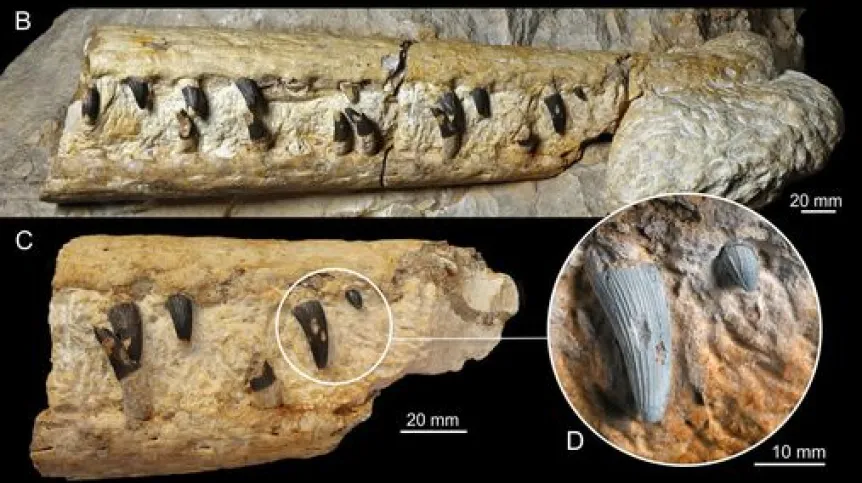
Scientists have re-examined the remains of a prehistoric marine reptile found in the 20th century in the village of Załęcze Wielkie (Łódź province). This distant relative of modern crocodiles was about four metres long and had a visible jaw injury, which it probably suffered in the first years of its life.
The evolutionary history of crocodylomorphs is as long as that of dinosaurs. One of their numerous evolutionary lines were large, predatory marine reptiles, colloquially referred to as marine crocodiles (Thalattosuchia). They were relatives of today's crocodiles, but even better adapted to life in water. They were included into fully marine metriorhynchids and amphibious teleosauroids.
'They lived in the Jurassic and Early Cretaceous, i.e. about 200 to 130 million years ago', says Łukasz Weryński, a doctoral candidate at the Institute of Geological Sciences of the Jagiellonian University.
In Poland, most marine crocodiles have been found in Western Pomerania, especially in Czarnogłowy, which was rich in fossils of these animals. They were discovered at the end of the 19th and the beginning of the 20th century. Individual specimens were also found outside Pomerania, for example in Inowrocław and the vicinity of the Kraków-Częstochowa Upland.

'There are much fewer of them in our part of Europe than in Western Europe, where specimens with complete skulls up to 1.2 meters long have been found. Outside Europe, the remains of marine crocodiles have been discovered, for example, in North Africa, India, Colombia', Weryński says.
The first well-documented specimen of a crocodylomorph from south-central Poland comes from the village of Załęcze Wielkie in the Wieluń Upland. It is an incomplete rostrum, i.e. a fragment of the animal's jaw. Dinosaur researcher Teresa Maryańska described, illustrated and identified it as a small pliosaur (Peloneustes) in 1972. British researchers, who re-examined the specimen from Załęcz Wielki in 2011, classified it as a teleosauroid (Teleosauridae).
The specimen has not yet been fully prepared because it was stuck in a hard, compact rock. In addition, as Weryński points out, it was originally described in a rather short paper that briefly presented its characteristics.
Scientists from the Jagiellonian University, the Institute of Palebiology of the Polish Academy of Sciences and the University of Edinburgh decided to return to the crocodylomorph from Załęcze Wielkie. They extracted it from the rock and performed additional tests using micro-computed tomography. Although preparing it from hard rock was a challenge, it turned out that it was well preserved. The results of the study are described in the journal PeerJ.
The presence of a small fragment of the nasal bone allowed to estimate the approximate length of the animal's skull. 'We estimate that it reached about 80 centimetres. Marine crocodiles had a much larger head in relation to the rest of their body compared to modern crocodiles. The proportion was about one to five. Our crocodylomorph could have been 4-4.5 meters long, so it was a large animal, the size of a large alligator', Weryński says.
Based on comparisons with other crocodylomorphs, the researchers have determined that the specimen from Załęcze Wielkie is a fossil of a machimosaurid (Machimosauridae). Machimosaurids are a family of amphibious teleosauroids, represented by the largest, macropredatory forms. 'Our specimen is too fragmentary to establish a new genus, but it cannot be ruled out that it is a new taxon', Weryński adds.
The width of the snout, the position of the nostrils, the presence of densely located sensory pits on the bones allowing to locate approaching fish, and large, massive teeth show that these crocodylomorphs were opportunistic predators. 'However, our specimen was adapted to smaller or medium-sized prey, not necessarily focused on feeding on bones or larger prey, like its largest relatives - the genus Machimosaurus. It hunted what it could find', says Weryński.
Snout deformation is also characteristic of the specimen from Załęcze Wielkie. 'The front part of his nasal cavity is severely deformed. This deformation was probably the result of an injury or degeneration, but it was difficult to determine its genesis. Most likely, this reptile had been living with this deformation from the beginning of its life, or for a very long time', says Weryński.
The studied rostrum is part of the collection of the Museum of the Earth of the Polish Academy of Sciences in Warsaw. The specimen is on display at the Museum of the Earth from May 10. (PAP)
PAP - Science in Poland, Ewelina Krajczyńska-Wujec
ekr/ bar/ amac/ kap/
tr. RL













